How to Find the Right ATX PC Cases for Your Requirements
There are a lot of ATX cases for PCs on the market these days. How do you know which one is the best option for you?
An ATX PC case is a computer enclosure used to protect and store all the delicate electronic components of a desktop computer. The casing itself is usually made from steel, aluminum, or plastic. It often comes with various features, such as cooling fans, airflow ducts, water cooling support, and cable management options. Here’s what you need to know about ATX PC cases:
When Do Users Use an ATX PC Case?
People use an ATX PC case to protect and store the delicate electronic components of their desktop computers. You might want to buy a case if you’re building a new computer, or if you need to replace an old one.
What Are the Different Types?
There are three main types of ATX PC cases: tower, desktop, and mini-tower cases.
Tower Cases: Tower cases are the tallest type of ATX PC case. They’re typically about 18 inches tall and can hold a lot of components, making them ideal for gaming computers or other high-end machines.
Desktop Cases: Desktop cases are shorter than tower cases, but they’re wider. They’re typically about 12 inches wide and 14 inches deep.
Mini-Tower Cases: Mini-tower cases are typically about 12 inches tall and can hold fewer components than tower or desktop cases.
What Are the Different Case Materials?
The most common type of material typically used for ATX cases is steel. Steel is strong and durable, but it’s also heavy. Aluminum is another popular material. It’s lighter than steel, but it’s not as strong. Plastic is the lightest material used for these PC cases, but it’s not as durable as steel or aluminum.
Here are a few helpful tips to help you find the right ATX PC case for your requirements:
1. Consider Your Budget
There is a range of ATX PC cases available at different price points. Choose the one that fits your budget and meets your needs.
Some cases offer features like panoramic views or vertical GPU mounting, adding to the cost. But if those features are significant to you, it may be worth paying a little more.
On the other hand, if you are looking for a basic case that will do the job, you don’t have to spend much money.
Just consider all your needs and wants when making your decision.
2. Think About Your Hardware
Not all cases are created equal. Some are designed to accommodate larger or taller hardware, while others may be smaller or more compact.
If you have a specific piece of hardware in mind that you want to use in your build, make sure the case you choose can support it.
Otherwise, you may be limited in your choices or end up having to make some compromises.
Similarly, if you have a lot of hardware, you’ll need to make sure the case can accommodate everything. Otherwise, you may need to buy multiple cases or get creative with your layout.
Again, it’s all about knowing your needs and matching them to the right case.
3. Consider Your Style
Some cases may be more minimalist, while others may have more flashy or eye-catching designs. Think about the look and feel you’re going for with your build and choose a case that matches.
If you can’t decide among two or three different cases, sometimes it can help to go with the one with the most features you want and then add a few custom touches to make it your own.
Finding the right ATX PC case is all about knowing what you need and what’s important to you. So, take your time, do your extensive research, and choose wisely. Your perfect case is out there waiting for you.
Here are some cool features to look for in an ATX PC case:
– Panoramic views
– Vertical GPU mounting
– Included PCI-E riser cable canopy
With so many different options in PC cases on the market, it can be tough to choose the right one. But if you keep these tips in mind, you’re sure to find the perfect ATX PC case.
Also Read: How You Should Use Your Computer to Boost Work Productivity
Conclusion:
When looking for ATX PC cases, it’s important to consider all of your needs and wants. Some cases offer features like panoramic views or vertical GPU mounting, adding to the cost. But if those features are critical for you, it may be worth paying a little more. Think about the look and feel you’re going for with your build and choose a case that matches.




